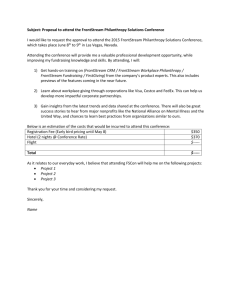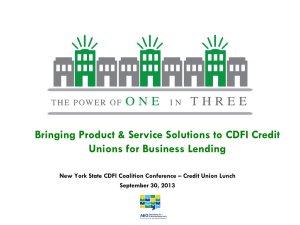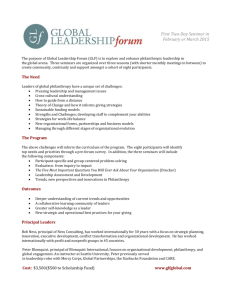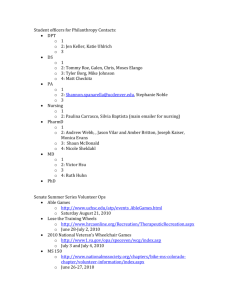John Lucero - seToolbelt
advertisement
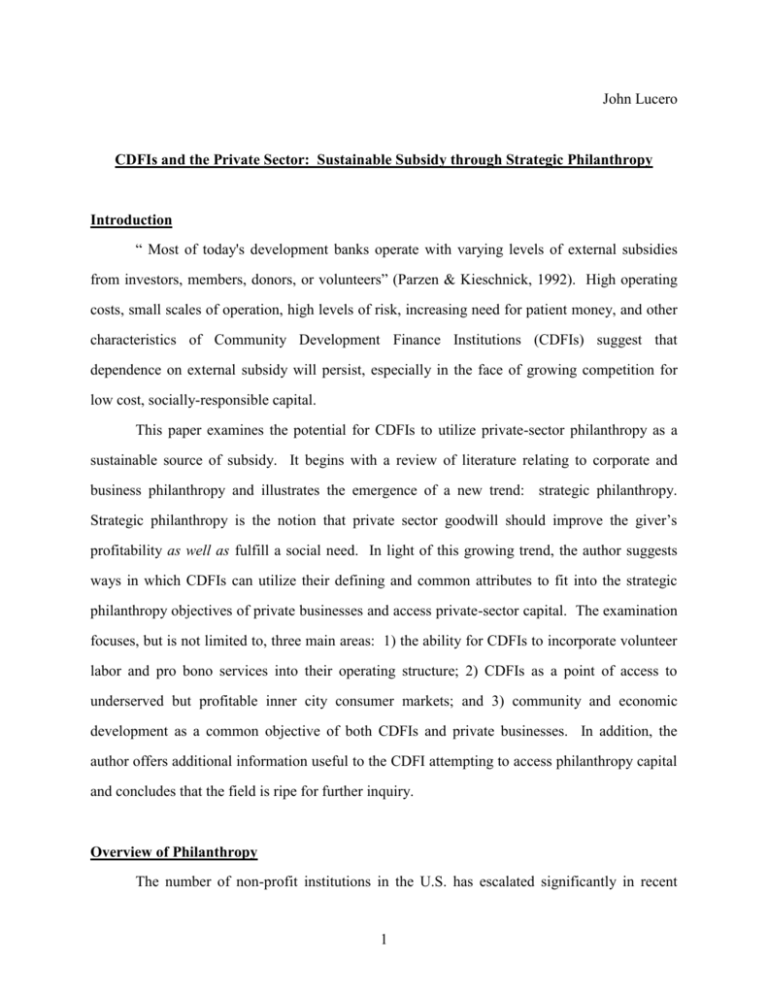
John Lucero CDFIs and the Private Sector: Sustainable Subsidy through Strategic Philanthropy Introduction “ Most of today's development banks operate with varying levels of external subsidies from investors, members, donors, or volunteers” (Parzen & Kieschnick, 1992). High operating costs, small scales of operation, high levels of risk, increasing need for patient money, and other characteristics of Community Development Finance Institutions (CDFIs) suggest that dependence on external subsidy will persist, especially in the face of growing competition for low cost, socially-responsible capital. This paper examines the potential for CDFIs to utilize private-sector philanthropy as a sustainable source of subsidy. It begins with a review of literature relating to corporate and business philanthropy and illustrates the emergence of a new trend: strategic philanthropy. Strategic philanthropy is the notion that private sector goodwill should improve the giver’s profitability as well as fulfill a social need. In light of this growing trend, the author suggests ways in which CDFIs can utilize their defining and common attributes to fit into the strategic philanthropy objectives of private businesses and access private-sector capital. The examination focuses, but is not limited to, three main areas: 1) the ability for CDFIs to incorporate volunteer labor and pro bono services into their operating structure; 2) CDFIs as a point of access to underserved but profitable inner city consumer markets; and 3) community and economic development as a common objective of both CDFIs and private businesses. In addition, the author offers additional information useful to the CDFI attempting to access philanthropy capital and concludes that the field is ripe for further inquiry. Overview of Philanthropy The number of non-profit institutions in the U.S. has escalated significantly in recent 1 years. According to a 1997 Urban Institute report, there are more than one million groups recognized by the IRS as non-profit organizations, 600,000 of which had charitable, tax-exempt status under Section 501(c)(3) of the IRS Code as of 1994. “Between 1989 and 1994, the number of public charities reporting to the IRS grew by 6.3 percent annually, compared with national population growth of 1.1 percent” (DeVita, 1997). As a result, competition for capital from traditional sources--foundations and socially-minded investors, for instance--is growing more intense. At the same time, many non-profits and their causes face cutbacks in funding from the federal government as well as umbrella organizations such as the United Way (Mckenna, 1995). It follows that the capital necessary to fund the operations and mission of CDFIs will have to increasingly come from the private sector. “‘Many community and civic groups, reeling from cutbacks in federal and state programs, are looking to local companies to fill the gap.....budget cuts are creating a lot of uncertainty among community organizations. ÔThey expect us to be part of the solution’” (Miller, 1997a). The private sector represents a significant source of financial capital for CDFIs, particularly when capital is sought through charitable giving and sustainable philanthropic partnerships. According to the American Association of Fund Raising Counsel, the 1995 level of charitable gifts by companies and corporate foundations was $7.4 billion. Even after adjusting for inflation, this number, which represents a 7.5% increase over 1994 levels, exceeds the previous record for annual giving of $7.32 billion set in 1986. Since 1995 the number has continued to grow, and 1996 levels increased another 7.6% to $7.9 billion (Counsel, 1997; Miller, 1997a). “The trend will likely escalate as corporations continue to search for ways to stretch their promotional dollars. In fact, most major corporations now have sponsorship programs representing 10 to 25 percent of their marketing budgets” (Johnson, 1994).1 These statistics illustrate the potential of private businesses and corporations as sources of It is important to note that the level of charitable giving for a given year does not equate to an amount of cash made available to charitable organizations for operating expenses. Corporate donations are sometimes made in the form of stock or earmarked for particular uses such as capital improvements. 2 cash and in-kind resources for CDFIs. To actually access this capital, however, it is not enough simply to recognize how much funding is available from the private sector. Tends in business giving must also be examined. For example, corporations are increasingly emphasizing noncash contributions such as property, equipment, and company products (Miller, 1997a). Survey results published by The Conference Board--a business research organization located in New York City--indicate that, although 95% of their respondents donate cash, two-thirds also participate in in-kind giving, 53% make product donations, and noncash giving accounts for 17% of respondents’ total giving (Miller, 1997a). Such information can give a CDFI insight on how to attract donations. For instance, CDFIs interested in sustaining giving levels with a particular corporation may ask for noncash contributions which enable corporations to “keep giving levels up when their cash coffers are low” (Miller, 1997a). Finally, an investigation of private-sector giving does more than indicate that corporations are taking their social responsibility seriously or reveal trends such as an increase in in-kind giving. Most importantly, inquiry into private-sector philanthropy explains why business give the way they do and uncovers a new type of private-sector giving--strategic philanthropy. For the CDFI which relies so heavily on external subsidy, an understanding of the motivations behind private-sector giving is key to tapping the private sector as a capital resource. The most fundamental piece of knowledge for the CDFI, as recognized by Keith E. Ferrazzi, a national director at Deloitte & Touche Consulting Group, is that “companies are realizing that philanthropy is simply good business” (Miller, 1997a). 3 Strategic Philanthropy “Strategic philanthropy” is a term that has developed from the realization that an effective corporate philanthropy program can benefit society while also serving business interests (Riggan, 1997). Any grant can be a source of good will, but strategic philanthropy is meant to improve company profits through targeted giving that corresponds to company interests (Riggan, 1997). Instead of simply donating resources to worthy causes, corporations now look for giving opportunities that are “newsworthy or reach specific constituencies such as elected officials, and create specific positive impressions” (Riggan, 1997). For a business engaged in strategic philanthropy, success is measured as much by social benefit as it is by improvements to the bottom line. With a strategic approach, companies invest in philanthropy for a number of social and business reasons, fostering pivotal relationships, burnishing images and generating positive impressions useful to business development, including newly developing markets. It also establishes connections between corporations and institutions with complementary missions, such as the universities that supply the field with ideas and talent, or community organizations which provide legitimacy to the utility's expansion plans. Frequently, working partnerships are developed with these players. Finally, strategic philanthropy can help companies indirectly market products and services, often to clearly defined market segments (Riggan, 1997 emphasis added). The move towards strategic philanthropy suggests that businesses will be interested in establishing meaningful and sustainable relationships with socially-committed entities. Some corporations, for example, “want to Ôown’ a cause. Whether it be Avon with breast cancer or McDonald's with Ronald McDonald Houses, companies are making a long-term commitment to one cause and trying to make a difference...” (Cooper, 1997). Long term relationships lead to strong bonds of identity between businesses and non-profits and help develop an ethical and caring reputation for a company. According to Carey Raymond, principal at Boston-based The Image Development & Public Relations Group, “Long-term commitment offers ongoing media attention and makes consumers, employees, shareholders, and the community embrace the company. This positive perception has an impact on profitability" (Cooper, 1997). [C]ompanies are responding to a growing insistence by customers to deal only with businesses that have a good image--an image that philanthropy can build. 4 Firms also feel a need to help fill the gap created by cutbacks in federal and state aid to nonprofit groups, as well as to polish their own tarnished images when they, too, have downsized. And finally, corporations now often are run by baby boomers who grew up with a sense that philanthropy is an important corporate responsibility (Miller, 1997a). Strategic philanthropy is not just for major corporations. Local business can profit from it, also--especially when the sustainability of the business depends on the impact of its giving. In Green Bay, Dan Bollom, CEO of Wisconsin Public Service Corp, after realizing that there was a shortage of qualified job applicants in the community where his company is located, played a key leadership role in a business-education partnership which aims to transform 10 school districts in the Green Bay Area (Riggan, 1997). In light of the growing competition for private-sector contributions and the popularity of strategic philanthropy, socially-oriented entities that hope to secure contributions or establish sustainable relationships with businesses must develop their approaches wisely. Being a successful donation-seeker entails more than emphasizing the benefit that a contribution or partnership holds for the company. One must first identify opportunities for mutual benefit. Identification requires thoughtful consideration of the qualities and strengths unique to the recipient that can be put to work to fulfill the needs and desires of the giver. The following sections further examine the phenomenon of strategic philanthropy in light of the many common operating characteristics and human and financial capital needs of CDFIs. It is hoped that this investigation will be useful in suggesting ways for CDFIs to take advantage of the changing trends in private-sector giving as well as identify opportunities for CDFIs to add value to their own operations and those of private-sector entities through strategic philanthropy. The next section focuses on three key attributes of CDFIs: their need for volunteer and pro bono services; their access to underserved and profitable consumer markets; and their role in community and economic development Volunteerism and Pro Bono services 5 Most, if not all, development banks derive critical benefit from the participation of volunteers. In fact, even mainstream financial intermediaries rely on the contribution of donated labor. In contrast to commercial banks, for example, “credit unions usually include a board of five to nine volunteers who together donate fifty hours per month, a supervisory committee of three to five volunteers who together donate twenty hours per month, and a credit committee of four volunteers who together donate fifty hours per month” (Parzen & Kieschnick, 1992). For the CDFI, volunteer labor is instrumental in reducing staff compensation which can be a major percentage of operating expenses. According to Parzen and Kieschnick, employee compensation comprises 45% of operating expenses and staffing costs are 35% higher than the average financial institution (Parzen & Kieschnick, 1992). Volunteers can reduce operating costs for the CDFI in other ways. Technical assistance, for instance, represents a large financial burden for development banks since it is costly to provide and often too expensive for borrowers to pay for. Shifting the cost of technical assistance elsewhere is another common way in which development bankers improve their cost structure (Parzen & Kieschnick, 1992). Lincoln National “loans” executives to non-profit groups; the objective is to lend the executives' financial and organizational skills to the nonprofits' projects (Mckenna, 1995). Venture Fund, a $1.25 million venture-capital fund in San Francisco, partners with an investment-banking firm which accepts the costs of identifying, reviewing, and underwriting the deals in which the venture fund invests (Parzen & Kieschnick, 1992). The provision of technical assistance further benefits CDFIs by reducing lending risk. In Los Angeles, Merril Lynch provides business management and development services to borrowers of CDFI funds (Lynch, 1997; Seiberg, 1996). To summarize, committed volunteers contribute greatly to the sustainability of CDFIs by: lowering costs and allowing these entities to focus their financial resources on lending and economic development; bringing in professional expertise from the private sector; and facilitating long-term relationships and reducing staff turnover . Volunteers can also play a role in reducing a CDFI’s exposure to risk by offering technical assistance and business advisory 6 services. Obtaining long-term and valuable volunteer service, then, will continue to be an important goal for the CDFI. Happily, volunteering programs are also valuable to corporations and private businesses. A joint survey performed by IBM and the School of Business at Columbia University showed a positive correlation between community involvement and return on assets, return on investment, and employee productivity (Caudron, 1994a; Caudron, 1994b). Private-sector entities are becoming aware of the returns that volunteer programs and charitable service provision bring to their bottom line. In a recent poll by Boston College's Center for Corporate Community Relations, “of some 181 community-relations executives surveyed 79% indicated their companies conduct volunteer programs; 51% loan executives to community causes; 33% have formal policies providing paid time off for volunteer work; [and] 73% offer awards or other recognition for volunteer service....” [Miller, 1997 #62]. The emerging corporate trend of encouraging volunteerism also improves employee morale, strengthens employee loyalty to their company, and provides opportunities for employees to learn new skills useful in their work (Caudron, 1994b; Deady, 1994; Flynn, 1994; Mullen, 1997; Svendsen, 1997; Yafie, 1996). Volunteerism “improve[s] workers' sense of identity with their firms, which in turn can translate to lower turnover and absenteeism” (Miller, 1997a). It helps companies improve their images within certain communities. As Geoff Gephard, executive director of Arts United, the umbrella fund-raiser for arts puts it, “People give to people" (Mckenna, 1995). Moreover, because volunteerism and service provision does not represent a cash outlay, businesses may prefer it over cash donations and find it easier to sustain during hard times. This also allows small and young businesses to reap the benefits of corporate philanthropy. In Fort Wayne, Indiana, Don Wood, president of a local business called 80/20, donated materials to be used in the creation of a children’s exhibit at a local museum. “Science Central got materials for an exhibit; Wood contributed to an educational cause that appealed to him and gave his small, young company exposure. And he got the pleasure of watching his grandchildren climb all over 7 the exhibit on opening day” (Mckenna, 1995). Small businesses represent an important source of private sector capital for urban CDFIs since in some cities they account for an increasing amount of employment (Mckenna, 1995). The donation of materials can also help CDFIs overcome the burden that fixed costs often pose to their small-scale operations. As we have seen, the provision of volunteer and pro bono services can be beneficial to both CDFIs and private-sector entities. Considering the value of volunteer labor and pro bono service provision to CDFIs, these institutions will want further develop strategies to attract inkind services. Market exposure There are other attributes of CDFIs that make them desirable targets for the strategic philanthropy efforts of private businesses. CDFIs and private businesses share common ground in that they are both entities which can fulfill their respective missions by targeting underserved, often minority, inner-city populations. Notable individuals such as Michael Porter of the Harvard Business School and John McIlwain, President and CFO of Fannie Mae, have long touted the untapped wealth of the inner-city consumer market (McIlwain, 1997; Porter, 1995). According to Market Segment Research & Consulting Inc., Miami, disposable income totals approximately $244 billion for Hispanics, $341 billion for African Americans and $107 billion for Asians (Theodore, 1996). One of Blockbuster Video’s most profitable stores nationally is located in Harlem, while some of the most successful McDonalds franchises are located in inner cities (McIlwain, 1997). “Strategic philanthropy can help companies indirectly market products and services, often to clearly defined market segments” (Riggan, 1997). Thus, CDFIs can be useful vehicles for corporations wishing to improve exposure and image within urban markets and among minorities. Corporations are finally taking note of this market and use giving programs to initiate new business--one of the top three motivators for strategic philanthropy (Yafie, 1996). CDFIs can initiate sponsorships and partnerships with private companies to increase 8 operating revenues and improve accessibility to financial capital by targeting sponsors with similar goals and demographic audiences (Allen, 1996; Johnson, 1994; Mullen, 1997). Essence Magazine and Anheiser Busch are examples of just two companies that are focusing their sponsorship efforts on minority populations in order to create cross-promotional, public relations and other marketing possibilities (Theodore, 1996; Walters, 1997). Recently, Merril Lynch announced a $77 million, three-year pilot partnership with The Greenlining Institute and The Orange County Alliance, two organizations that represent CDFIs and other entities involved with economic development among minorities in urban Southern California. “Designed to tap the enormous entrepreneurial energy and economic potential of Southern California's culturally diverse communities,” the program will include $20 million in lending to small businesses in historically underserved markets; $5 million in small business equity investments; $250,000 in complimentary business advisory services to established small businesses in target communities; and $150,000 in advisory services through a regional multiethnic business association to provide planning services to very small businesses (Lynch, 1997; Seiberg, 1996). Besides being consonant with the objectives of CDFIs, the partnership serves the interests of Merril Lynch. According to Merrill Lynch Chairman and Chief Executive Officer Daniel P. Tully and President and Chief Operating Officer David H. Komansky, "This partnership makes plain good business sense. One of our strategic objectives is to expand our relationships in markets in and out of the U.S. where we expect significant wealth creation over the next decade. We are also pleased because this program is entirely consistent with our Merrill Lynch Principle of Responsible Citizenship" (Lynch, 1997; Seiberg, 1996). Other examples of sponsorships and partnerships read similarly. Chase Manhattan bank has identified the untapped wealth of the low- and moderate-income homebuyer of inner-city Los Angeles. In September the company entered into a partnership with the Urban League to promote home ownership among minority populations. In return for providing $50 million in capital for home loans and $60,000 in funds for homeownership and borrowing seminars, the 9 Urban League will provide Chase with potential applicants from its computer database. As Pazel Jackson, senior vice president in the Community Development Group at Chase, puts it, “We feel very fortunate to work as partners with the Urban League and Operation Hope. Our partnership is an enormous benefit to us because it simplifies the recruitment process" (Simons, 1997). Sumitomo Bank recently granted $25,000 to a revolving loan fund in Oakland, California. According to the loan fund’s director, “We trust that this will be the beginning of a long and mutually beneficial relationship” (Sumitomo, 1997). It seems, then, that partnerships that take advantage of CDFIs’ strategic positions in underserved markets represent a growing vehicle for much-needed lending and operating capital. Moreover, the above relationships are part of sustainable, long-term strategies. The Chase partnership, for instance, comprises only a small portion of the $18.1 billion Chase intends to invest in low- and moderate-income communities (Simons, 1997). Partnerships can be initiated by something as simple as offering selective access to a depositor database or mailing list or be part of a multi-entity alliance. The bottom line, however, is that the people served by CDFIs are a vital resource for attracting private dollars. Community and Economic Development There is a synergy between the function of CDFIs and the needs of local businesses and corporations which can give CDFIs an important edge in competing for the philanthropic contribution. CDFIs foster economic development and provide other financial services within a specific geographic area--a neighborhood, for instance. Thus, to the extent that businesses rely on the health of a particular neighborhood or geographic area for income, businesses have a survival interest in the impact of the CDFI. The Utility Business Education Coalition, for example, recognizes that “wires and pipes that deliver their products keep them firmly rooted in their communities,” and that the health of local businesses--their base customers--is an essential objective of an economic development and strategic philanthropy program (Riggan, 1997). In light of the symbiotic relationship between the economic health of neighborhoods and private 10 business (Reder, 1995), it is no wonder that for the past five years, a GTE committee handling its philanthropic budget has determined that the number one funding priority is economic development (Mckenna, 1995). “The most effective sponsorships are local” (Ukman, 1995). Philanthropic funds are often administered by local offices of companies that have an interest in increasing local exposure or seeing local impact. “...[T]o position itself locally in markets visited by the Searssponsored Phil Collins tour, the retailer ensured that funds raised...in conjunction with each stop went not to some large, national organization, but directly into those communities” (Ukman, 1995). Small and mid-sized local businesses, which often prefer spending funds on sponsorships, represent an untapped sector of the business community (Kahan, 1997; Mckenna, 1995). Even though sponsorships are traditionally associated with a particular event or function, CDFIs could modify the concept to apply them to special lending programs or funds and name them in honor of the appropriate sponsor. Finally, psychological ties to a community play a role (Caudron, 1994b; Pearson, 1996). ...STEELCASE Inc., an office-furniture manufacturer, continues to target its gifts to local organizations in its headquarters city of Grand Rapids, Mich., and four other U.S. plant communities--as it has for 45 years. ÔWhen you're a privately held company as we are and grow up in a community, you feel strong ties to that community,’ explains Kate Pew Wolters, executive director of the Steelcase Foundation. To her, Ôgiving back to the community’ provides Steelcase the most bang for its philanthropic buck--a strategic decision in itself. ÔStrategic giving,’ she insists, Ôis different than market-based giving’ (Miller, 1997a). The geographic and community focus of CDFIs may be valuable in perpetuating strategic philanthropy funding (Barnett, 1997). According to Marilyn Moran Townsend, CEO of Custom Video and chairwoman of the United Way of Allen County, corporate donors now take “a harder look at what happens to their money. Non-profits expect to be under greater scrutiny not only as to how they spend money, but what their results are” (McKenna, 1995). Donors also expect to see how their philanthropy meets community needs (Dendiger, 1995; Dillon, 1996; Mckenna, 11 1995; Miles, 1995; Reder, 1995; Svendsen, 1997). Fortunately for CDFIs, the effects of their business efforts are highly tangible. Lending figures from a CDFI financial statement allow donors to track funds while a tour of a new business itself could become a powerful psychological way to perpetuate giving. The scrupulous accounting that CDFIs perform as financial institutions also helps reassure would-be donors. According to Ladonna Huntley James, corporate public involvement officer of Lincoln National, “We try to investigate each agency we fund” (Mckenna, 1995). Making the connection Having identified the benefits of strategic philanthropy, it seems appropriate to offer insight as to how CDFIs might approach private businesses to initiate and nurture mutually beneficial relationships. Perhaps the least burdensome way for CDFI to establish contact with private businesses is through a national, regional, or local community service clearinghouse. The United Way, for example, supports an 800 number which can connect companies interested in becoming involved with non-profits to a local action center (Greco, 1997). Businesses for Social Responsibility, a group of civic-minded entrepreneurs, has 11 networks across the country (Greco, 1997). Local and regional organizations, such as the Donors Forum of Ohio, work with companies interested in starting up or strengthening volunteering programs with their employees (Caudron, 1994b). Because of their established exposure and the fact that businesses often utilize such organizations, it is important for CDFIs to advertise opportunities through them. The more entrepreneurial CDFI will want to contact companies directly, however, in order to more effectively compete for private-sector attention. One way is to work through the formal volunteer programs of larger companies. A survey conducted by Boston College's Corporate Community shows that almost 80% of companies have a formal volunteer program (McCafferty, 1997), many of which serve a specific purpose. For instance, Equifax, a credit reporting company, has a program meant to ease the transition into retirement which allows older employees to “sign on” with a non-profit agency for up to two years while remaining on the 12 Equifax payroll (Flynn, 1994). Some law firms expect new hirees to perform pro bono and volunteer work to gain professional experience while other businesses see volunteer opportunities as ways to gain new business contacts, experience in strategic planning, experience in working with different constituencies, better understanding of social patterns and of government policies and regulations, and the opportunity to work with leaders in the community (Cannella, 1997; Caudron, 1994b). This suggests that CDFIs do background research to identify company goals and present volunteer opportunities that fit within company volunteer objectives and programs. To take advantage of existing volunteer programs, CDFIs should contact the Human Resources or personnel departments of businesses. Recently, 11% of companies surveyed by the Conference Board reported that they manage their volunteer efforts through the personnel or human resources departments (Caudron, 1994a). CDFIs should be ready to answer the types of questions companies are likely to ask when selecting a volunteer partner. Before she says yes or no to any board assignment, [one] should ask herself a few questions such as: Will service on this board help me grow, learn and serve in the most effective way possible? What does the organization expect in terms of a financial and fund raising commitment? Are board members expected to serve on working committees, and if so, how much actual work do they do? What do other board members think of the organization? Does the board offer visibility or networking opportunities? (Sirinek, 1996) Some business intend to participate in community service, but have not yet committed. According to a survey of 454 U.S. corporations by the Points of Life Foundation and the Conference Board, 50% make community service part of their company mission statement and 68% allow employees to take time off with pay during working hours for volunteer activity (Miller, 1997b). Many businesses are actively looking to initiate employee volunteer programs. A useful strategy for the CDFI can be research directed at identifying businesses that have not fulfilled community service goals which may be articulated in mission statements. Such documents are often readily made available to the public for public relations purposes. Whether the program is existing or new, companies give year-round to causes because 13 they touch the hearts of their top executives (Mckenna, 1995). According to Al Zacher, owner of the Zacher Co, “Personal contacts and interests play an important role. Giving comes more readily when there is a personal relationship between the person asking and the potential donor” (Mckenna, 1995). This suggests that CDFIs should approach businesses through current volunteers, perform research to find out to what causes executives have donated in the past, or focus on businesses whose employees provide services which can be of value to CDFIs (Dean, 1996). CDFIs might establish contacts with a key corporate executive as part of a longer-term strategy (Dean, 1996; McCafferty, 1997). Since many companies develop volunteer programs according to employee feedback, it may be helpful even to contact employees of a company and familiarize them with a CDFI’s cause (Greco, 1997). Once a CDFI has established a volunteer/personal relationship with a business, it can look to cultivate the relationship to include other types of giving. This can also be done through existing volunteers. For example, employee volunteers often recommend organizations they're involved with for corporate grants and keep working with those organizations to assure the investment is well spent (Sirinek, 1996). The Conference Board survey also revealed that 49% run incentive programs, such as "dollars for doers" programs in which they donate money to charitable organizations for which employees volunteer (Miller, 1997b). Furthermore, many companies also have programs that match employee-initiated contributions to charitable organizations (Sirinek, 1996). “There was a time when commercial companies viewed charities as teams of slightly dippy do-gooders. Now they see effective advertising, successful direct marketing campaigns and highly persuasive corporate donor programmes” (Bond, 1996). Community service entities are crying out for marketing expertise. “The development of strong relationships remains one of the greatest challenges faced by volunteer and staff leadership” (Dean, 1996). Where possible, CDFIs may want to organize a staff or position committed to initiating and maintaining relationships with the private-sector (Parzen & Kieschnick, 1992). The specialized knowledge and contacts developed through such efforts would become an invaluable asset to the CDFI. “If 14 you read both the current and earlier literature on volunteers you will discern that key concerns are their demographic characteristics, techniques for their recruitment, training and recognition” (Pearson, 1996). Besides cultivating certain skills, a CDFI “philanthropy coordinator” would offer a competitive edge when approaching businesses. “How can you argue with people who put their money where their hearts are, and who give more than lip service?” (Dean, 1996). Finally, common sense is an important asset when building and maintaining useful relationships. “Avoid shortcuts and take time because each prospect must be individually assessed and an individual plan designed (Dean, 1996)” Sustainable partnerships should start small and grow after a few examples of success. Doing this helps create a personal touch and shows how the relationship can be of value to the business (Sirinek, 1996). CDFIs should also remember to appropriately acknowledge their benefactors beyond improvements to the bottom line. At Blue Cross and Blue Shield of Arizona, employees who volunteer 100 or more hours to a cause in a year receive a sky-blue acrylic trophy (Cannella, 1997). Further investigation of strategic philanthropy reveals even more changes in the way business go about their charitable giving. One study notes that large employers are more likely than small businesses to have a formal process for giving (Mckenna, 1995). Also, corporate contributions are coming “not out of corporate charitable-giving budgets, but from the budgets of public affairs, marketing, or other corporate business units” (Miller, 1997a). The bottom line is that a thorough understanding of strategic philanthropy and trends in private sector giving is instrumental in successful solicitation of private-sector capital. Conclusion This paper has identified the potential for CDFIs to initiate and maintain long-term and mutually beneficial relationships with the private sector through an understanding of strategic philanthropy. It has also presented information useful to the CDFI interested in tapping the private sector as a sustainable source of subsidy. Still, the most valuable knowledge will come 15 from CDFIs and the lessons they learn from their successful and unsuccessful attempts to solicit donations of labor and capital or build partnerships with the private sector. Their efforts will be invaluable to answering important questions: How can CDFIs play a role in strengthening ties between business and government through strategic philanthropy? How might the Community Reinvestment Act be used as tool for creating mutually beneficial partnership between CDFIs and mainstream banks? Should a CDFI initiate a multi-pronged approach and contact employees, human resources and marketing departments simultaneously? If so, can this be done without a volunteer or staff devoted exclusively to private-sector relations? In light of the important mission of CDFIs and their constraints in fulfilling that mission, the more we learn about strategic philanthropy and efforts to take advantage of it the better. It is clear that the private sector will continue to shoulder many of the social responsibilities traditionally fulfilled by governments and other institutions. Yet, as far as the private-sector goes: “their money is limited and the requests seem infinite” (Mckenna, 1995). 16 Works Cited Allen, S. (1996, May). 12 Steps to Non-profit Sponsorship Success. Fund Raising Management, 27, 46(3). American Association of Fund Raising Council (1997). Giving Reaches $150.7 Billion (Company Press Release ). New York: AAFRC. Barnett, M. (1997, August). A Cause for Pride: Community Marketing Reaches Customers Where They Live and Solves Real Issues and Needs. Progressive Grocer, 76, 19(1). Bond, C. (1996, February 29). Charity Begins with the Market. Marketing, XII(2). Cannella, D. (1997). Volunteers Make a Difference. The Business Journal, 17(25), 43B(1). Caudron, S. (1994a). Volunteer Efforts Offer Low-cost Training Options. Personnel Journal, 73(6), 38(5). Caudron, S. (1994b, February 21). Volunteerism and the Bottom Line. Industry Week, 243, 13(4). Cooper, C. (1997, March). Give and Thou Shall Receive. Sales and Marketing Management, 149, 75(2). Deady, T. (1994). Southland Firms Step Up Employees' Volunteer Work. Los Angeles Business Journal, 16(8), 3(1). Dean, J. (1996, April). The Key to Major Gifts: Cooperative Relationships. Fund Raising Management, 27, 26(6). Dendiger, M. J. (1995, August). Making Sponsorships Work. Meetings and Conventions, 30, 30(1). De Vita, Carol J. Charting Civil Society. www.urban.org/PERIODICL/cnp/cnp_1.htm. Washington, D.C.: The Urban Institute 17 Dillon, P. (1996). Banks Help Community Foundation Grow. Orlando Business Journal, 13(30), 25(1). Flynn, G. (1994). Volunteerism Helps Community and Company. Personnel Journal, 73(7), 28(4). Greco, S. (1997, September 1997). Volunteering: the New Employee Perk. Inc., 19, 116(2). Johnson, M. (1994, September). Sponsorships Offer Image, Budget Boosts. American City & County, 109, 12(1). Kahan, S. (1997, July). Funding Cuts Mean Cultural Institutions Need Your Help. The Practical Accountant, 30, 30(5). Lynch, M. (1997). Merrill Lynch, Greenlining Institute and Orange County Alliance Announce Economic Development Partnership (Company Press Release). Los Angeles: Merrill Lynch. McCafferty, J. (1997, August). A Higher Reward: Voluntarism Attracts a new Breed of "Financial Angel". CFO, The Magazine for Senior Financial Executives, 13, 24(6). McIlwain, J. (1997). Presentation at 1997 ULI National Conference. New York: ULI. Mckenna, L., & Le Duc, D. (1995, Dec 18). Corporate Philanthropy Grows Increasingly (Press Release). New York: Knight Ridder. Miles, L. (1995, July 6). Results Service. Marketing, 23(1). Miller, W. H. (1997a, September 2). Citizenship that's Hard to Ignore. Industry Week, 245, 21(3). Miller, W. H. (1997b, September 1). Volunteerism: a New Strategic Tool. Industry Week, 246, 13(3). Mullen, J. (1997). Performance-based Corporate Philanthropy: how "Giving Smart" can Further Corporate Goals. Public Relations Quarterly, 42(2), 42(7). Parzen, J. A., & Kieschnick, M. H. (1992). Credit Where It's Due: Community Development Banking for Communities. Philadelphia: Temple University Press. 18 Pearson, G. B. (1996, August). Is it Time for a Paradigm Shift on Volunteers? Fund Raising Management, 27, 12(3). Porter, M. E. (1995). The Competitive Advantage of the Inner City. Harvard Business Review, Reder, A. (1995). The Wide World of Corporate Philanthropy. Business and Society Review, Winter(92), 36-42. Riggan, J. E. (1997, August). Strategic Corporate Philanthropy Serves Vital Business Development. Electric Light & Power, 75, 44(2). Seiberg, J. (1996, September 12). Merrill Lynch Commits $77M to Invest in Urban Los Angeles. American Banker, 161, 3. Simons, D. Q. (1997, September). Building hope in Los Angeles: Chase Manhattan Bank Leads Charge to Start Home Ownership Initiative. Black Enterprise, 28, 22. Sirinek, L. H. (1996, September 13). Employee Volunteering Program a Worthy Option. Business First-Columbus, 13, 12A(1). Sumitomo. (1997). Sumitomo Bank Awards $25,000 to Bay Area Urban-Renewal Agency (Company Press Release). San Francisco: Sumitomo Bank. Svendsen, S. (1997, June 9). Building Relationships with Microcommunities. Marketing News. 31, 13(1). Theodore, S. (1996, July). Rich in Diversity: Knowing your Ethnic Customers can be Essential to Marketing Success. Beverage Industry, 87, 40(2). Ukman, L. (1995, October). Increasing Local Visibility: How Retailers use Sponsorship to Drive Store Traffic. Do-It-Yourself Retailing, 169, 70(2). Walters, N. R. (1997). Extending your Retail Marketing with Sponsorships. Journal of Property Management, 62(3), 52(5). Yafie, R. C. (1996). Giving Back. Journal of Business Strategy, 17(2), 52(3). 19 73(3), 55-71.




